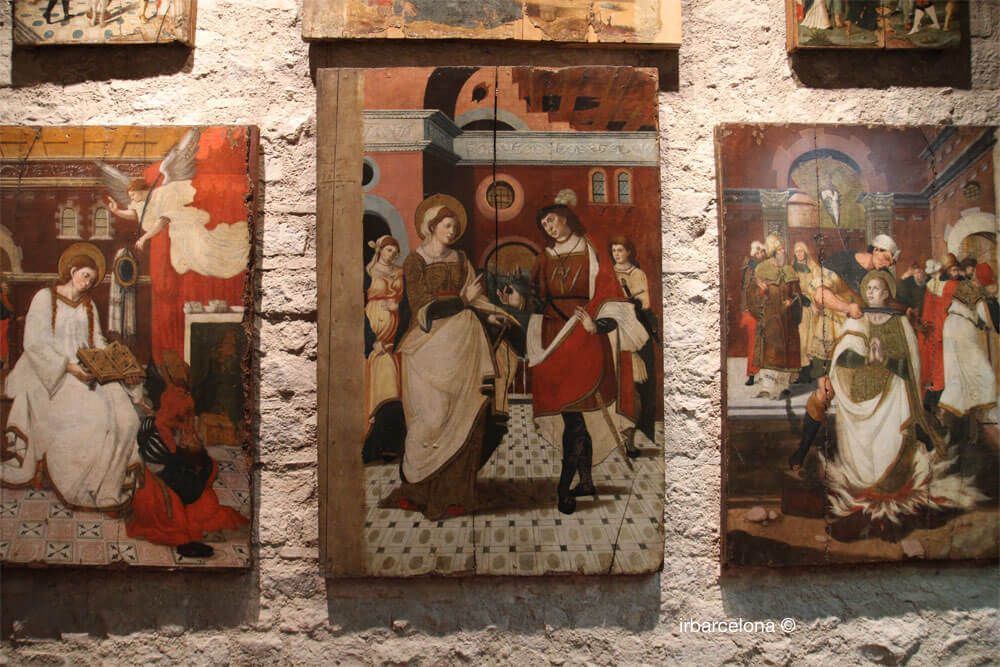
Updated Jun 01 2023
In the Plaça de la Seu, next to the Cathedral, you will find Barcelona’s Diocesan Museum, whose official Catalan name is Museu Diocesà de Barcelona, in which works of art that have been donated by churches belonging to the diocese of Barcelona are exhibited.
Information about the Diocesan Museum of Barcelona
Opened in 1916 in the conciliar seminary building, after some major renovations from 1991 the Diocesan Museum has been housed in the building known as the ‘Casa de la Pia Almoina’ (House of the Blessed Charity), also referred to as ‘la Canonja’ (the Canonry), as it was the former residence of a community of San Agustín canons.

The building forms part of a group of medieval buildings that are integrated into Barcelona’s Roman wall that dates back to the 4th century AD. By contrast to the renaissance and gothic styles of the Casa de la Pia Almoina, the much more modern entrance door to the museum stands out. Made of steel by the artist Josep Plandiura and the sculptor Enric Pla Montferrer, it has become one of the building’s iconic features.
The permanent museum collection
Throughout the building’s three floors around 3000 items are on display, amongst them paintings, sculptures, ceramics and religious clothing, all of different artistic styles and which date from the late Roman era right up to the twentieth century. The origin of the majority of these works of art comes from the various churches that make up the Obispat de Barcelona (Barcelona’s Bishopric).
Although it might not be one of the city’s unmissable museums, Barcelona’s Diocesan Museum is the ideal place for lovers of religious art, and especially for those who have a particular interest in Romanesque and Gothic art, as well as art in general, history and culture.

Romanesque Art
The works of Romanesque art make up a large part of the collection and are some of the most valuable works on display. Highlights include the frescos of Sant Salvador de Polinyà as well as various altarpieces and sculptures.
Some of the most important works of Romanesque art
Frescos of Sant Salvador de Polinyà
Statue of la Virgen de Toudell
Bishop’s staff of Abad Clasquerí
Processional cross of Riells del Fai
Alb and cloak of Abad Biure
Gothic Art
Originating from various churches, the museum displays some important Gothic pieces, highlights of which include paintings on wood and altarpieces of various saints.
Some of the most important works of Gothic art
Painting of Sant Jaume
Painting of Sant Vicenç, by Ramon de Destorrent
Retablo of St John the Baptist, by Jaume Serra
Reliquary chest of Sant Cugat
Painted wooden tomb of Santa Maria de Cervelló
Renaissance
Although there aren’t as many Renaissance pieces on display as from other eras, the museum does exhibit some of great value, such as various altarpieces by major artists of the time.
Some of the most important works of Renaissance art
Retablo of Sant Marçal i Sant Sebastià, by Joan Gascó
San Cristóbal, by Francesc Ribes
Retablo of Sant Sever, by Pere Nunyes and Enric Fernandes
Custodia de Santa Maria del Pi, by Llàtzer de la Castanya
Baroque
The museum’s baroque collection centres around paintings such as ‘Santa Cena’ (‘The Last Supper’) by Antoni Viladomat, but there are also various sculptures on display.
Some of the most important works of Baroque art
Santa Cena, by Antoni Viladomat
San Antonio de Padua, by Antoni Viladomat
Talla San Jaime Peregrino
19th and 20th Centuries
Although many of the works from this period have been lost during the difficult political times in Barcelona as well as in the rest of Catalunya and Spain, some managed to escape damage in the burning of churches and in times of vandalism.
Some of the most important works of the 19th and 20th centuries
La Purísima, by Alexandre de Riquer, 1887
Rosetón Sanctus, by Antoni Gaudí, 1892
Terracotta Ángel del Juicio, by Agapit Vallmitjana i Barbany, 1884
San José con el Niño, by Josep Llimona
As well as the permanent collection the museum always has one or two temporary exhibitions, which aren’t always limited to sacred art but they are usually closely related to art. Many of the temporary exhibitions have kept a link with Antoni Gaudí, who, as well as being a celebrated architect was also a devout believer.
Photo gallery
Map
Address
Avinguda de la Catedral 4, Barcelona.
Opening hours
Tuesdays to Saturdays (except public holidays): from 10:00 to 14:00.
Sundays: from 11:00 to 14:00.
6th and 8th December: from 17:00 to 20:00.
Mondays: closed.
Entry cost
General admission: €6.
Concessions: €3 for students, senior citizens, the unemployed, registered large families and groups of 10 people or more.
How to get there
Metro: Jaume I (line 4), Plaça Catalunya (lines 1 and 3) y Liceu (line 3).
Buses: lines 14, 17, 19, 45, 59 and tourist bus.
On foot: Right next to the Cathedral, it’s in the heart of the city centre and you can walk from most places in the city.
Nearby places of interest
Barcelona Cathedral
Barcelona Archdeacon’s House
Frederic Marès Museum
Plaça del Rei (Barcelona King’s Square)
Columns of the Temple of Augustus in Barcelona








